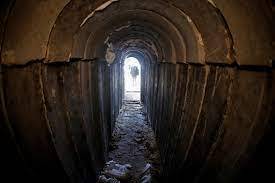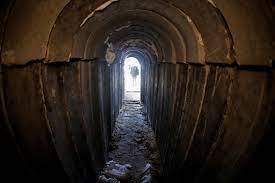After gaining control of a tunnel belonging to the Islamic Resistance Movement (Hamas) in northern Gaza, a group of Israeli soldiers descended into the tunnel with some unusual equipment. These were not explosives or robotic sensors or firearms for direct combat, but rather vintage radio devices with a dial to tune into stations. Their mission was to go down until the devices could no longer receive radio signals from Israel. They found that this point was at a depth of between 10 and 12 meters, which is generally considered the upper "levels" of the Palestinian militants' tunnel network.
The experiment took place on January 4, at the request of Israeli Communications Minister Shlomo Karhi, who had just expanded the most popular army radio in the country, which broadcasts on FM waves, to include AM frequencies. The broader AM range means that emergency updates will have a better chance of being heard by civilians in shelters. The troops in Gaza would also benefit, as they were allowed transistor radios to stay informed while being asked to surrender their mobile phones for fear that Hamas might pinpoint their geographic location.
Karhi told Reuters, "It occurred to me suddenly that some of these hostages might have access to transistor radios... If they have the means to hear their families, it would be significantly valuable in terms of morale... and for their relatives as well." This maneuver likely requires cooperation from Hamas, a possibility that the initiators hope is within reach.
There was no immediate contact with Hamas officials in Gaza to comment on the idea, highlighting the destruction of Palestinian infrastructure in the Israeli attack, as well as their reluctance to disclose information about the conditions of the hostages.
Among the dozens of hostages released during the ceasefire in November, several reported that their captors allowed them limited access to televisions or radios. One hostage learned from the radio that her husband and daughter, whom she was separated from after the attack, were still alive. For another hostage, Israeli broadcasts were the first notification of two of her relatives among the deceased. However, the narratives did not clarify whether the hostages were in a location directly underground, in tunnels that do not receive radio signals, or in safe houses above ground that regularly receive radio waves. The tunnels shown by Israeli forces to journalists in the sector sometimes reached depths of about 10 meters.
In response to a request for feedback on the army radio initiative, former hostage Nili Margalit noted that part of her captivity was spent at a depth of 40 meters underground. She told Reuters that it was "very deep" and declined to elaborate for fear that "the terrorists might use my words to harm the hostages still there."
Peter Duffy-Smith, an honorary lecturer in astrophysics at the Cavendish Laboratory at Cambridge University, stated that AM transistor radios designed for passive reception are not easily traceable, though he did not rule it out. He added that most of these devices use oscillators that emit weak signals, "and can potentially be detected from a distance using specialized equipment. These signals diminish rapidly with increased distance, especially through the ground."
In response to whether Israel could conduct such operations for location determination, Danny Zakine, the director of army radio, stated, "We can't. The broadcast received by the radio does not return. I mean, it's not like sonar... it's one-way only, unfortunately."
Karhi indicated that he understands that neither Israel nor Hamas can track passive AM wave reception. Hence, permission was granted for troops in Gaza to use transistor radios. Mitigating despair or rebellion among the hostages might lead the captors to consider the risk of using radios.
The shift of the army radio to AM waves is supported by the National Emergency Management Authority of the Ministry of Defense and Israel's largest telecommunications company, Bezeq. The station pre-records messages from the families of hostages to broadcast them several times a day. Zakine said, "They are telling them... Hold on to your strength. We are fighting for you. Don't worry. We will reach you. Hold on to your strength."
During a march in Tel Aviv to celebrate the first birthday of Kfir Bibas, the youngest hostage, an army radio reporter approached Yossi Schneider, a relative of the child, explained the new range of radio wave coverage, and requested an interview. Schneider said, "If they are listening to us... we want to tell you that your parents love you, and no one has forgotten you."




